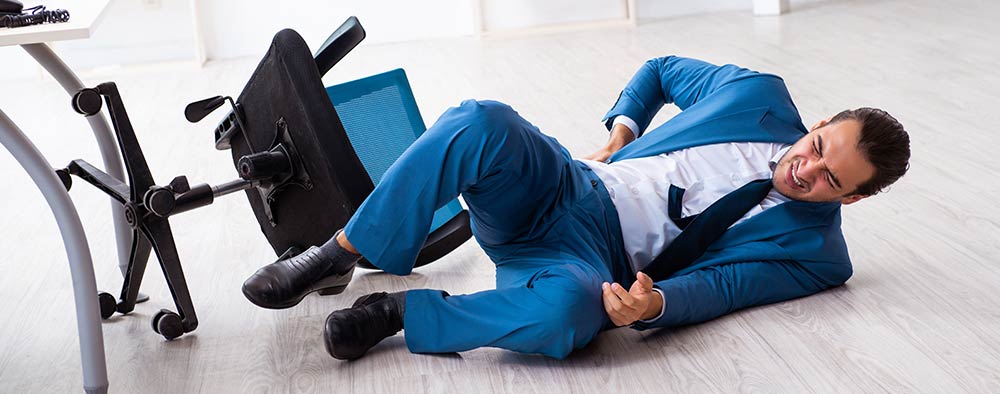by Brent Hearn •
There’s a decent chance you’ve read an article or two about how to avoid falling. Heck, we’ve mentioned it ourselves. (Read Don’t Slip Up: Keep Your Footing in Winter Weather here.)
But if you’ve ever been unfortunate enough to suffer a fall, you know one very important thing. There comes a moment when you realize it’s inevitable. At that point, no amount of knowledge about how to avoid a fall is helpful. What you need to know is how to avoid an injury—or at the very least, mitigate one. Let’s see what we can do about that, shall we?
It’s Happening. Help It Happen Safely.
There are different strategies for falling as safely as possible, depending on whether you’re falling forward, backward, or sideways. And while it’s great to study, learn, and even practice these strategies, it may not always be realistic to believe that in the matter of seconds—or maybe even a fraction of a second—it takes to fall, you’ll be able to remember and perfectly execute the steps necessary.
That said, there are a few key concepts that are applicable regardless of exactly how you fall. Remembering those may make the difference between serious injury and a sore bum-bum.
Soften your landing.
It’s not always possible, but aim for softer ground (a couch, carpeting, etc.) if it’s available.
Relax!
I know, I know. It goes against your instincts. When it becomes evident that something that’s very much not a good thing is imminent, it’s easy to tense up, but that’s one of the worst things you can do. Once you realize a fall is unavoidable, don’t try to stop it; that’s how you break bones. Instead, to the extent possible, use the cushioning in your behind, upper thighs, and back to act as shock absorbers.
Roll with it.
The harder the impact, the greater the chance of injury. Try to spread the impact around by (quite literally) “rolling with it.” This is a time-tested technique martial artists and stunt performers use to reduce their risk of injury, and it can work for you too!
Protect your noggin.
Tuck your chin to your chest if you’re falling backward. Don’t look up!
Okay, You’ve Fallen. Now What?
The damage is done, so what do you do now? Well, the cardinal rule is very simple: Don’t make things worse.
Check yourself before you wreck yourself.
Whether it’s pride, stubbornness, or just a desire to go about your business, it can be tempting to pop right back up. Your adrenaline is pumping because you just went through something unexpected and scary, but don’t let that cause you to make a grievous error in judgment. You don’t want to turn one fall into two. Take some time to calm yourself and assess whether you’ve been injured—and, if so, to what degree.
Call for help.
If you don’t think you can get up safely on your own, call for help. If someone else is within earshot, yell for assistance. If there’s no one nearby and you’re within arm’s reach of a phone, smartwatch, or other device, call 911. (Now is the time we tell you that if you know you’re prone to falls, you should really consider investing in a medical alert system; some even have built-in fall detection.)
But be aware that “helping” can make things worse.
If someone is able to offer assistance and they have any doubt they can safely help you up—or you’re not sure you can help them help you—the best thing they can do is call 911. Trying to help someone up after a fall comes with its own risks. It’s very easy for a would-be good Samaritan to become injured (and for you to become more injured) if they don’t have specialized training. Watch this video on helping others after a fall embedded within the linked article, and encourage your spouse, roommate, or caretaker to do so as well.
Get up—carefully.
If there’s no one around to assist you and you think you’re able to get up on your own, it’s very important to do so as mindfully and carefully as possible. Use whatever available means to assist you; don’t try to stand straight up. If you can crawl or scoot on your behind to a piece of furniture or some stairs, that might help you get to your feet safely.
Get checked out.
Even if you think you’re fine, it doesn’t hurt to get checked out by a chiropractor or physician. There may be damage you’re not yet aware of, and it’s better to be safe than sorry.
Read the articles linked below to learn more about how you can fall safely—and what to do after a fall. We hope you never have to use any of this knowledge, but it’s definitely better to have it in ye olde memory bank just in case.
Sources:
AARP: The Safest Way to Get Up From a Fall
AARP: Learn How to Fall Safely from Hollywood Stunt Pros
Harvard Health Publishing: How to Fall Without Injury
Consumer Reports: Best Medical Alert Systems









 ▶︎
▶︎  Why is the Discount Challenge prize amount $15,024? Because that is the average “per-occurrence” fine for Medicare inducements. That’s not $15,024 per patient, that’s not per provider, that’s PER VISIT. Stinks, doesn’t it? To us, the prize amount is worth the investment if we can help our profession better understand proper discounting.
Why is the Discount Challenge prize amount $15,024? Because that is the average “per-occurrence” fine for Medicare inducements. That’s not $15,024 per patient, that’s not per provider, that’s PER VISIT. Stinks, doesn’t it? To us, the prize amount is worth the investment if we can help our profession better understand proper discounting.